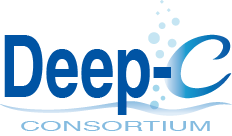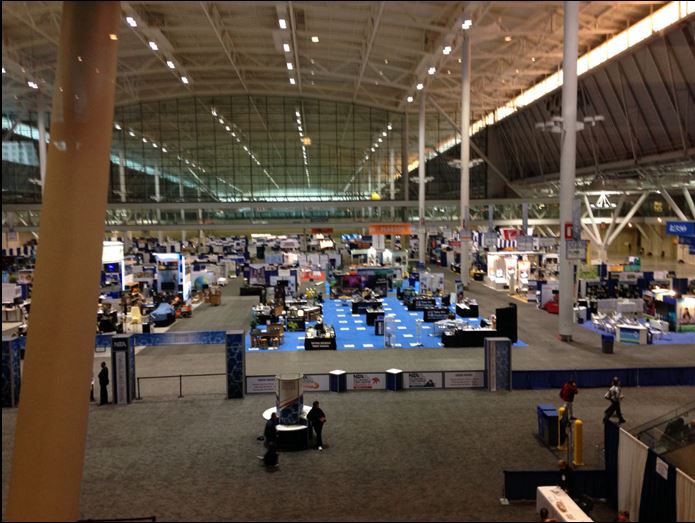Sea Lab Hosts Session on Using ROVs as a STEM activity at National Science Teachers Association (NSTA) Meeting
|
|
The annual meeting of the National Science Teachers Association (NSTA) is the preeminent meeting for formal and informal teachers in all scientific disciplines. This year’s event in Boston, MA attracted more than 10,000 teachers from across the US including Deep-C Education and Outreach member, Tina Miller-Way.
On April 3, 2014, Tina and Greg Graeber of the Discovery Hall Program at the Dauphin Island Sea Lab hosted a session focused on ROVs as a STEM activity. Titled Remotely Operated Vehicles: An engaging way to combine marine biology, engineering, and physical science, the hour event consisted of a presentation, discussion and build session highlighting DHP-DISL’s experience with their hands-on ROV class, ROVing the Gulf, as well as the Deep-C sponsored teacher workshop and annual student-built ROV competition. Session participants learned about the varied use of ROVs in ocean exploration, research and industry today; heard about the successes (and failures) of the DISL program as it developed and were able to participate in building the pvc and bilge pump motor-based ROV used in DISL’s programs. They discussed avenues to integrate this into their classrooms or clubs and ways to apply the engineering design process (a critical part of the Next Generation Science Standards - NGSS) for student-built ROVs. As a group, they explored a few short classroom activities designed to reinforce specific concepts underpinning ROV function such as buoyancy and learned how Deep-C research has been integrated into ROV missions for the student competition.
Headquartered in Arlington, VA, NSTA is the largest professional organization in the world promoting excellence and innovation in science teaching and learning for all. The more than 60,000 members include classroom teachers, informal educators, administrators, education and scientific research scientists as well as business and industry representatives. NSTA publishes several journals and books, hosts national and regional meetings, supplies professional development for educators and of course works to inform Congress and the public on questions affecting science literacy. Given the size of the meeting, not all submitted proposals are accepted and it is a privilege to be selected. As at scientific research meetings, plenary speakers are a big draw. Tina and Greg enjoyed hearing from Mayim Bialik, star of the TV show, The Big Bang Theory and science advocate as well as Bill Nye who spoke about his recent debate experience. One of the highlights of any NSTA meeting is visiting the exhibit hall, a vast space hosting hundreds of booths of vendors of scientific equipment, publishers, purveyors of educational field trips, federal and state agencies involved in education and outreach and even zoos and aquaria. Greg and Tina enjoyed seeing all of the new sensor technologies and apps available for K-16 students and noted that the new emphasis on robotics and the NGSS with its engineering design process fits very well with the ROV education program Deep-C funding has allowed them to develop.
For more information about DISL’s ROV class for students, go to http://dhp.disl.org/k12academic.htm#ROV. To see short videos of the student ROV competition, go to https://www.youtube.com/watch?v=kp8LLgkpI_o or https://www.youtube.com/watch?v=YNt2vw9IE68.
The Deep-C consortium is a long-term, interdisciplinary study investigating the environmental consequences of petroleum hydrocarbon release in the deep Gulf of Mexico on living marine resources and ecosystem health. The consortium focuses on the geomorphologic, hydrologic, and biogeochemical settings that influence the distribution and fate of the oil and dispersants released during the Deepwater Horizon accident, and is using the resulting data for model studies that support improved responses to possible future incidents.
|
|
Dr. Tina Miller-Way is Chair of Discovery Hall Programs for Education and Outreach at the Dauphin Island Sea Lab (DISL). The lab, located in southern Mobile County off Alabama's Gulf Coast, is well-known for their excellence in education and outreach programming. As a marine laboratory, DISL's mission encompasses marine science education, marine science research, coastal zone management policy and educating the general public through the Estuarium, Dauphin Island Sea Lab's public aquarium. The lab partners with more than 20 colleges and with primary schools to offer marine science coursework up to the graduate level. The research programs of the Dauphin Island Sea Lab range from biogeochemistry and oceanography to systems ecology. Most research focuses on the near-shore and estuarine processes of Mobile Bay, field sites of our internationally-renowned faculty include Mexico, Australia, and Croatia and other countries.
Deep-C was a four-year, interdisciplinary study of deep sea to coast connectivity in the northeastern Gulf of Mexico.Deep-C is no longer an active research project. The information on this website is for historical reference purposes only.
Home | About Us | Research Areas | Data Center | News & Multimedia | Education & Outreach
© Deep-C Consortium. All Rights Reserved.
This research was made possible by a grant fromThe Gulf of Mexico Research Initiative (GoMRI).
Copyright | Disclaimer | Privacy Policy

 The NSTA exhibit hall, Boston 2014
The NSTA exhibit hall, Boston 2014